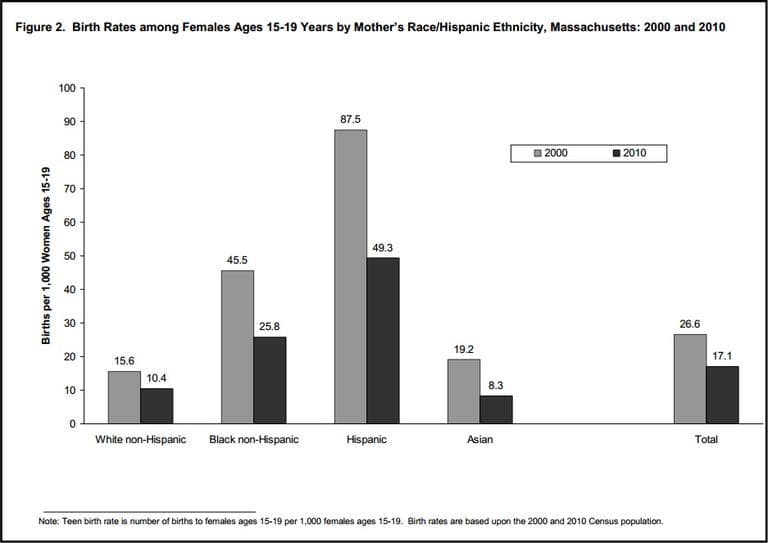Advertisement
Mass. Teen Birth Rate Falls To Historic Low
The Massachusetts teen birth rate has plummeted by more than 50 percent since 1989, reaching the lowest level on record in 2010, according to a Department of Public Health report (PDF) released Monday.
The study also showed new mothers in Massachusetts have grown older since 1980. The percentage of women giving birth who were 30 or older was 25 percent in 1980; it was 54 percent in 2010.

Racial disparities persist, according to the 121-page report. The black infant mortality rate of 8.2 per 1,000 live births was 2.5 times higher than the white rate. The birth rate for Hispanic teens, 49.3 per 1,000 women ages 15 to 19, was 4.7 times that of whites.
Overall, the teen birth rate of 17.1 births per 1,000 was down from the 2009 rate of 19.5, and was the lowest teen birth rate ever recorded, according to the study.
“Credit goes first to the young people of Massachusetts,” said Patricia Quinn, executive director of the Massachusetts Alliance on Teen Pregnancy, in a statement. “Youth behavior data shows that rates of sexual activity have not changed significantly, so it appears that much of the decline in teen birth rates can be attributed to youth effectively using contraception.”
The alliance noted that in 1989, the teen birth rate hit a peak of 35.9 per 1,000. New Hampshire was the only state with a lower teen birth rate in 2010 than Massachusetts.
While the highest 2010 teen birth rate in New England is Rhode Island, with a rate of about 22 per 1,000, according to the National Campaign to Prevent Teen and Unplanned Pregnancy, other areas of the country currently surpass the Massachusetts peak in 1989. Mississippi has a birth rate of 55 per 1,000 and is neighbors with other states with significantly higher rates than the Northeast.
Suburbs had the lowest rates of births by unmarried mothers, with Brookline (6.1 percent), Arlington (7.3 percent) and Newton (8.5 percent) recording the smallest percentages among the 30 largest communities. Springfield (71.4 percent), Lawrence (70.2 percent), New Bedford (64 percent) and Fall River (63.6 percent) were the highest.
The statewide percentage of unmarried mothers (34.6 percent) was lower than the nationwide rate of 40.8 percent.
Teen birth rates were also higher in so-called gateway cities generally outside Boston. The number of births per 1,000 women ages 15 to 19 was highest in Holyoke (83.6) followed by Lawrence (56.9), Springfield (54.3) and Chelsea (51.8).
The youngest mother in the state was 12 years old in 2010, the same as in 2009, the study said.
The report was prepared by James West, Malena Hood and Dana Bernson, epidemiologists from the Division of Research and Epidemiology, and Kevin Foster, from the Registry of Vital Records and Statistics.
The Massachusetts fertility rate of 53.7 births per 1,000 women ages 15 to 44 years was below the nationwide rate of 64.1 per 1,000.
In 2010, 6.3 percent of births involved mothers who smoked during pregnancy, according to the report.
Melrose-Wakefield Hospital had the highest percentage of caesarean section operations, with 43.1 percent. Brazilian mothers had the highest rate of caesareans (42.9 percent), among the state’s ethnicities, and Cambodian mothers had the lowest rate (19.9 percent).
The report said Asian mothers had the highest average age at birth (29.8 years) while Hispanic mothers had the lowest (23.5 years). Among the 30 largest municipalities, Weymouth had the highest percentage (92.9 percent) of mothers receiving “adequate prenatal care,” while Pittsfield (70.5 percent) had the lowest rate.
This program aired on April 1, 2013. The audio for this program is not available.